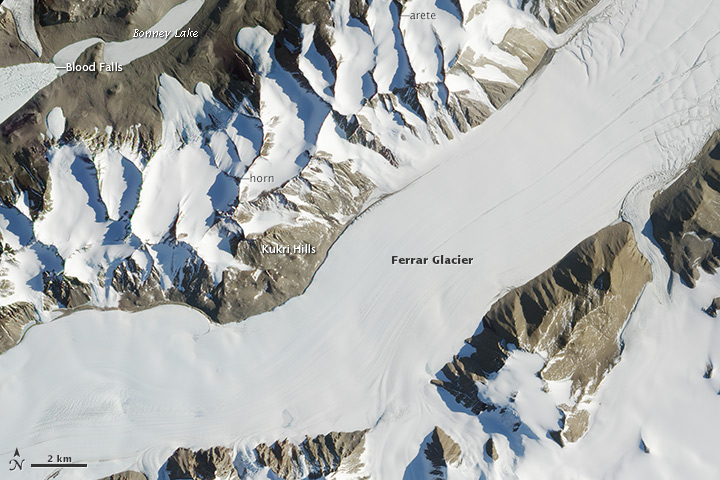NASA: Antarctica - Ferrar Glacier - 19.0713
Posted by Ricardo Marcenaro | Posted in NASA: Antarctica - Ferrar Glacier - 19.0713 | Posted on 16:12

acquired February 9, 2013
download large image (6 MB, JPEG, 7891x10171)
Editor’s Note: Today’s caption is the answer to Earth Observatory’s June Puzzler.
Ferrar Glacier begins in Victoria Land at Taylor Dome, a part of the larger East Antarctic Ice Sheet. Snow accumulates at Taylor Dome, compresses into ice with time, and flows downward toward the Ross Sea.
Some of this ice flows into Ferrar Glacier, a 35-mile (56-kilometer) river of ice discovered during the 1901-1904 British National Antarctic Expedition
and named after Hartley Ferrar, the expedition’s geologist. The glacier
flows down through the Royal Society Range until it reaches the Ross
Sea at a point near McMurdo Station, the largest research station in Antarctica.
The Advanced Land Imager (ALI) on NASA’s Earth Observing-1 (EO-1)
captured this view of the main trunk of Ferrar Glacier on February 7,
2013. The Kukri Hills just to the north serve as the dividing line
between Ferrar and the largely ice-free Taylor Valley. While most of Antarctica is covered by thick layers of ice, Taylor Valley and the other valleys that make up the McMurdo Dry Valleys are free of ice because relentless katabatic winds roll down from the ice sheet and rake moisture from the valley floors.
A small part of Taylor Glacier is visible in the upper left. Where
the edge of Taylor Glacier meets Lake Bonney, there is a unique feature
known as “Blood Falls.” Discovered in 1911 by a member of Robert Scott’s doomed expedition
to the South Pole, the name refers to a rusty stain of red that coats
part of the glacier and spills down toward Lake Bonney in a pattern that
makes it look like a blood-red waterfall.
It’s not actually a waterfall. Nor is any blood involved. The red comes from microbes
living within a pool of ancient seawater that has been trapped beneath
Taylor Glacier for at least 1.5 million years. Due to the activity of
the microbes, the seawater is rich with the iron-containing salt ferrous
hydroxide, which quickly oxidizes and turns red as it seeps out a crack
in the glacier.
Other interesting features are visible in the image. In the Kukri
Hills, there are a number of thin, serrated ridges of rock—called
arêtes.— Arêtes form when bowl-shaped cirque glaciers
grind away at mountainsides long enough to leave sharp ridges
protruding between parallel valleys. When three or more glaciers erode
toward each other, they can transform arêtes into dramatic
pyramid-shaped peaks, called glacial horns.
References
- Acton, Gary A Trip to Ferrar Glacier and Taylor Valley. Accessed June 21, 2013.
- Earth Observatory (2007, November 28) Ferrar Glacier. Accessed June 21, 2013.
- Earth Sky (2013, March 9) Blood Falls, five stories high, seeps from an Antarctic glacier. Accessed June 21, 2013.
- Find the Data Ferrar Glacier. Accessed June 21, 2013.
- Johnson, J. & Staiger, J. (2007, July 3) Modeling long-term stability of the Ferrar Glacier, East Antarctica: implications for interpreting cosmogenic nuclide inheritance. Journal of Geophysical Research: Earth Surfaces, 112 (F3).
- Nature News (2009, April 16 ) Life Thrives Beneath Antarctic Glacier. Accessed June 21, 2013.
- Slate (2008, October) Blood Falls, a Time Capsule Containing a Unique Ecosystem. Accessed June 21, 2013.
NASA Earth Observatory
image by Jesse Allen and Robert Simmon, using EO-1 ALI data from the
NASA EO-1 team. Caption by Adam Voiland. Congratulations to Allen Pope (National Snow and Ice Data Center) for being the first person to solve the puzzler.
- Instrument:
- EO-1 - ALI
Ricardo M Marcenaro - Facebook
Blogs in operation of The Solitary Dog:
Solitary Dog Sculptor:
http://byricardomarcenaro.blogspot.com
Solitary Dog Sculptor I:
http://byricardomarcenaroi.blogspot.com
Para:
comunicarse conmigo,
enviar materiales para publicar,
propuestas comerciales:
marcenaroescultor@gmail.com
For:
contact me,
submit materials for publication,
commercial proposals:
marcenaroescultor@gmail.com
My blogs are an open house to all cultures, religions and countries. Be a follower if you like it, with this action you are building a new culture of tolerance, open mind and heart for peace, love and human respect.
Thanks :)
Mis blogs son una casa abierta a todas las culturas, religiones y países. Se un seguidor si quieres, con esta acción usted está construyendo una nueva cultura de la tolerancia, la mente y el corazón abiertos para la paz, el amor y el respeto humano.
Gracias :)


Comments (0)
Publicar un comentario